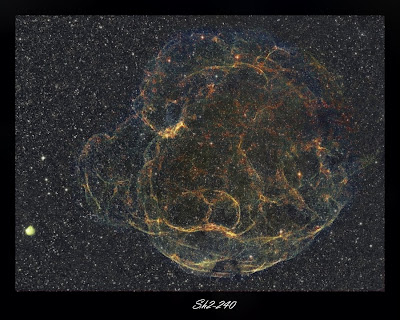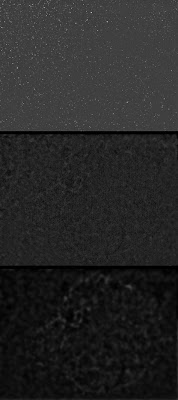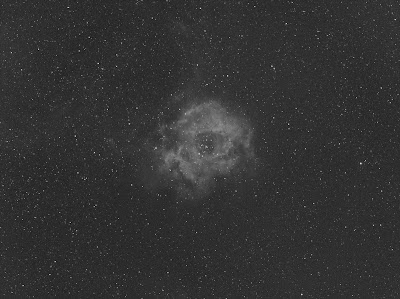COPYRIGHT, PLEASE NOTE
All the material on this website is copyrighted to J-P Metsavainio, if not otherwise stated. Any content on this website may not be reproduced without the author’s permission.
Have a visit in my portfolio
PORTFOLIO:https://astroanarchy.zenfolio.com/
Thursday, January 22, 2009
Rosette Nebula as a Stereo pair.


I turned this image of Rosette Nebula to a Stereo pair format by
adding some volume.
The result is more or less an educational guess about real 3D appearance of this formation.
-
Two versions, first for Parallel Vision , and the second for Cross Vision method.
-
The original image and the image information can be found here:
-
Viewing instructions, please, look for the Right hand side menu.
Labels:
stereo images
Saturday, January 17, 2009
Sh2-240, more lights


This is a second version of Sh-240 this year.
I added more H-a light. Now image is smooth and signal / noise is
improved. I might shoot more lights for this later in this spring.
-
Two versions, first in Hubble palette and secon in "natural" color narrowband composoite.
-
Exposures so far are:
H-alpha, 12x600s + 24x300s(binned 2x2) + 12x600s = 6h
S-II, 5x600s (binned 2x2)
O-III, 14x300s (binned 3x3)
-
Optics: Canon 200mm EF f1.8 @ f1.8 Camera: QHY9 @ -50 C Guiding: Lx200 GPS 12" + LQHY5 and PHD-Guiding - The information in O-III channel is extremely weak. I used a special technique of mine to dig it out for color information. This image serie shows how weak the O-III realy is.

Thursday, January 15, 2009
Sh2-240, a Supernova remnant. (Simeis 147)

I have never seen this object in HST narrowband colors.
After strucling with this last night, I don't wonder why.
This is a extremely difficult objekt it has a super low surface brightness and
it's huge!
This is a supernova remant in Taurus & Auriga
it has the angular diameter of 200'x180'.
Thats about 8 full Moon!
-
There was very litle data on O-III channel.
With extreme stretching and by using the method I have developed for narrowband work, some O-III glow can be clearly be seen deep down in data.
-
Total exposure time was relatively short doe the very fasr f1.8 optics.
-
Exposures:
-H-alpha 12x600s binned 1x1+ 24x300s binned 2x2, total 4h
-S-II 5x600s binned 2x2
-O-III 14x300s binned 3x3
Optics:
Canon 200mm EF f1.8 @ f1.8
Camera:
QHY9 @ -50 C
Guiding:
Lx200 GPS 12" + LQHY5 and PHD-Guiding
-
The information in O-III channel is extremely weak.
I used a special technique of mine to dig it out for color information.
This image serie shows how weak the O-III realy is.


Here is a Starless version to better show the nebulosity.
-
I keep coming back to this fascinating object, there is something mysterious
about its appearance and the fact, that it's difficult to shoot makes it even more interesting.
-
Here is some elaier tryouts with Sh2-240:
Thursday, January 8, 2009
QHY9 & Canon EF 200mm f1.8 "Startest"

NOTE,
The JPG image is large, 2,7mb.
(You have to load the image from Picassa to see it in Full Resolution.)
-
NOTE2,
The image looks litle soft. It's not doe the optics or focus but
very low altitude of the object up here North.
The maximum elevation was 29 degrees when Rosette was imaged.
-
-
Here is a single five minute exposure about Rosette Nebula.
Stars are pinpoint from edge to edge. I haven't test the Chromatic aberration
yet, since I'm shooting narrowband at the moment.
There should be very litle of it doe the exotic class in the lens system.
You can read more about it from here:
-
On the lower left corner stars are somehow stretched, thats not an optical flaw.
That happends when the camera is no absolute perpendicular to the lens.
The critical focus zone is only 7/1000mm and even slightest tilt can be seen in the image.
I'll correct thet later by rotating the camera in M42 0.75mm thread to an
other position.
-
This is a single calibrated 5min. image.
Flat, Bias and One Dark frame for bad pixels is used.
Image is then stretched and converted to 8bit doe the JPG algorithm.
No other image processing is done.
-
DETAILS:
Optics, Canon EF 200mm f1.8L @ f1.8
Camera, QHY9 astro camera
Guiding, QHY5 and PHD-Guiding on LX200 GPS 12"
Exposure, 1x300s
Filter, Baader 7nm H-alpha
Labels:
research and development
Subscribe to:
Posts (Atom)








